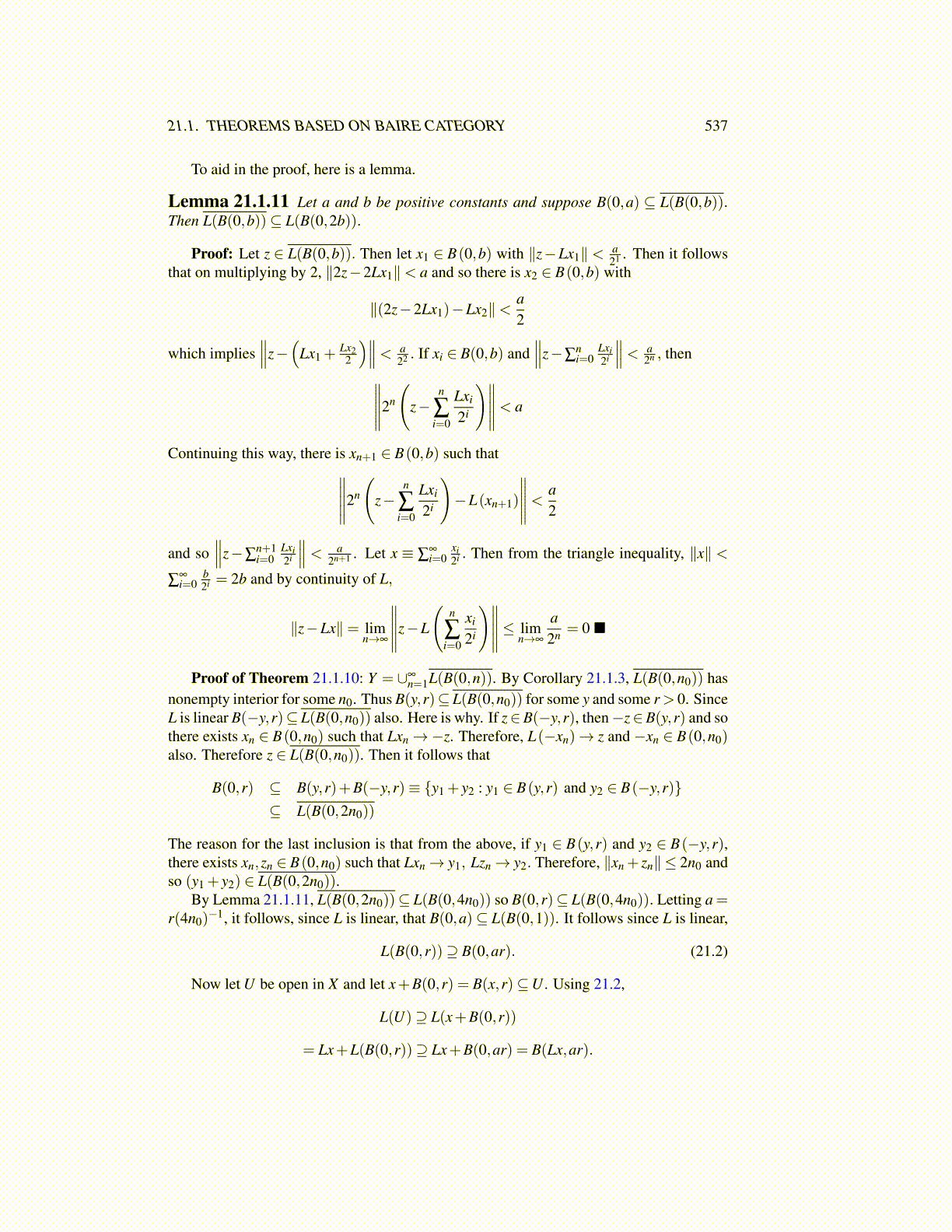
21.1. THEOREMS BASED ON BAIRE CATEGORY 537
To aid in the proof, here is a lemma.
Lemma 21.1.11 Let a and b be positive constants and suppose B(0,a) ⊆ L(B(0,b)).Then L(B(0,b))⊆ L(B(0,2b)).
Proof: Let z ∈ L(B(0,b)). Then let x1 ∈ B(0,b) with ∥z−Lx1∥ < a21 . Then it follows
that on multiplying by 2, ∥2z−2Lx1∥< a and so there is x2 ∈ B(0,b) with
∥(2z−2Lx1)−Lx2∥<a2
which implies∥∥∥z−
(Lx1 +
Lx22
)∥∥∥< a22 . If xi ∈ B(0,b) and
∥∥∥z−∑ni=0
Lxi2i
∥∥∥< a2n , then∥∥∥∥∥2n
(z−
n
∑i=0
Lxi
2i
)∥∥∥∥∥< a
Continuing this way, there is xn+1 ∈ B(0,b) such that∥∥∥∥∥2n
(z−
n
∑i=0
Lxi
2i
)−L(xn+1)
∥∥∥∥∥< a2
and so∥∥∥z−∑
n+1i=0
Lxi2i
∥∥∥ < a2n+1 . Let x ≡ ∑
∞i=0
xi2i . Then from the triangle inequality, ∥x∥ <
∑∞i=0
b2i = 2b and by continuity of L,
∥z−Lx∥= limn→∞
∥∥∥∥∥z−L
(n
∑i=0
xi
2i
)∥∥∥∥∥≤ limn→∞
a2n = 0 ■
Proof of Theorem 21.1.10: Y = ∪∞n=1L(B(0,n)). By Corollary 21.1.3, L(B(0,n0)) has
nonempty interior for some n0. Thus B(y,r)⊆ L(B(0,n0)) for some y and some r > 0. SinceL is linear B(−y,r)⊆ L(B(0,n0)) also. Here is why. If z∈B(−y,r), then−z∈B(y,r) and sothere exists xn ∈ B(0,n0) such that Lxn→−z. Therefore, L(−xn)→ z and −xn ∈ B(0,n0)also. Therefore z ∈ L(B(0,n0)). Then it follows that
B(0,r) ⊆ B(y,r)+B(−y,r)≡ {y1 + y2 : y1 ∈ B(y,r) and y2 ∈ B(−y,r)}⊆ L(B(0,2n0))
The reason for the last inclusion is that from the above, if y1 ∈ B(y,r) and y2 ∈ B(−y,r),there exists xn,zn ∈ B(0,n0) such that Lxn→ y1, Lzn→ y2. Therefore, ∥xn + zn∥ ≤ 2n0 andso (y1 + y2) ∈ L(B(0,2n0)).
By Lemma 21.1.11, L(B(0,2n0))⊆ L(B(0,4n0)) so B(0,r)⊆ L(B(0,4n0)). Letting a =r(4n0)
−1, it follows, since L is linear, that B(0,a)⊆ L(B(0,1)). It follows since L is linear,
L(B(0,r))⊇ B(0,ar). (21.2)
Now let U be open in X and let x+B(0,r) = B(x,r)⊆U . Using 21.2,
L(U)⊇ L(x+B(0,r))
= Lx+L(B(0,r))⊇ Lx+B(0,ar) = B(Lx,ar).